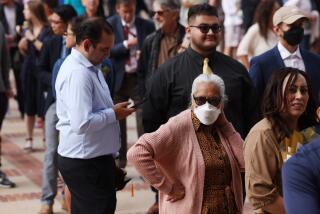AIDS: a Progress Report
- Share via
A dying wish of Max Robinson, the pioneering black network anchorman, was that his death from complications related to acquired immune deficiency syndrome--AIDS--be used by his survivors to energize the flagging effort to control the disease among minorities. That wish focuses attention on the greatest failure thus far in the public-health campaign to slow the spread of the deadly disease.
There has been an encouraging reduction in the rate of new cases among homosexuals, the most affected group. In Los Angeles County, homosexuals account for 89% of the cases. In New York, Los Angeles and San Francisco, the cities with the highest AIDS caseloads, there has been a particularly significant stabilization of the infection rate among white homosexuals. This suggests widespread behavior changes accepting safer sexual practices, including the use of condoms and avoidance of anal intercourse.
At the same time, however, there has been an increase in the cases of AIDS among black and Latino gay men; among intravenous drug users, including large numbers of minorities, and among blacks and Latinos generally. In the nation as a whole, minorities make up 20% of the population but account for at least 40% of the AIDS cases. In Los Angeles County, blacks and Latinos now constitute 31% of all cases, up from 29% just a year ago. In the county, intravenous drug users now make up 4% of the cases, compared with 3% a year ago. There is no evidence that public-health education efforts have succeeded in winning substantial behavior changes to safer sex practices in these groups and communities. There continues to be resistance to safer-sex proposals from both blacks and Latinos. And many of the minority organizations themselves have not made AIDS a high priority because of their preoccupation with other problems--including homelessness, hunger and unemployment.
County officials are initiating new programs to try, through advertising drives and community based organizations, to reach the minorities. Additional minority health educators are being added to the staff of the Los Angeles County AIDS office. But there is an acknowledgement that no one has yet developed a model program for reaching minorities. Some answers may come from major research projects, including work now under way by UC San Francisco in a section of San Francisco with many minority residents.
There is cause for some encouragement that longer-term planning is beginning to take shape. Los Angeles County is moving ahead with blue prints for a new $3-million outpatient clinic at County-USC Medical Center. The present clinic caseload of 1,500 a month is expected to rise to 5,000 in the years ahead. The first dedicated AIDS ward at County-USC Medical Center will open next year, allowing acute care to be concentrated. Plans are being developed to make available the costly AZT drug not only to those with AIDS but also to persons with the human immunodeficiency virus when its use is indicated as a means of postponing the development of AIDS symptoms. Home care has been expanded this year into a $1.2 million-a-year program to maintain more AIDS patients in their homes. And the new AIDS hospice at Barlow Hospital will soon open, the first of four planned by the AIDS Hospice Foundation, while Christopher Street West is moving ahead with another foundation to open the Casa del Sol Hospice for 18 patients next June in a converted apartment building.
In the city of Los Angeles, Mayor Tom Bradley has announced plans to establish a city AIDS office to coordinate efforts. That could facilitate additional responses within the city in cooperation with the county Department of Health Services and the county AIDS Commission. The mayor has promised $1 million over a two-year period from the Community Redevelopment Agency to address the housing needs of AIDS victims--a good beginning.
The sense of progress and momentum stands in contrast with what public-health officials would have faced at this time had the reckless and punitive Proposition 102 passed in November. It would have diverted desperately needed funds to marginal activities. The wisdom of the voters in rejecting that initiative is measured by what is being accomplished.






